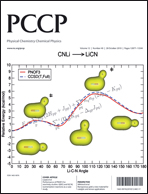Hydrogen bonding in electronically excited states: a comparison between formic acid dimer and its mono-substituted thioderivatives
Abstract
A multi-state complete active space second order perturbation theory (MS-CASPT2) study on the valence singlet electronic excited states of


 Please wait while we load your content...
Please wait while we load your content...